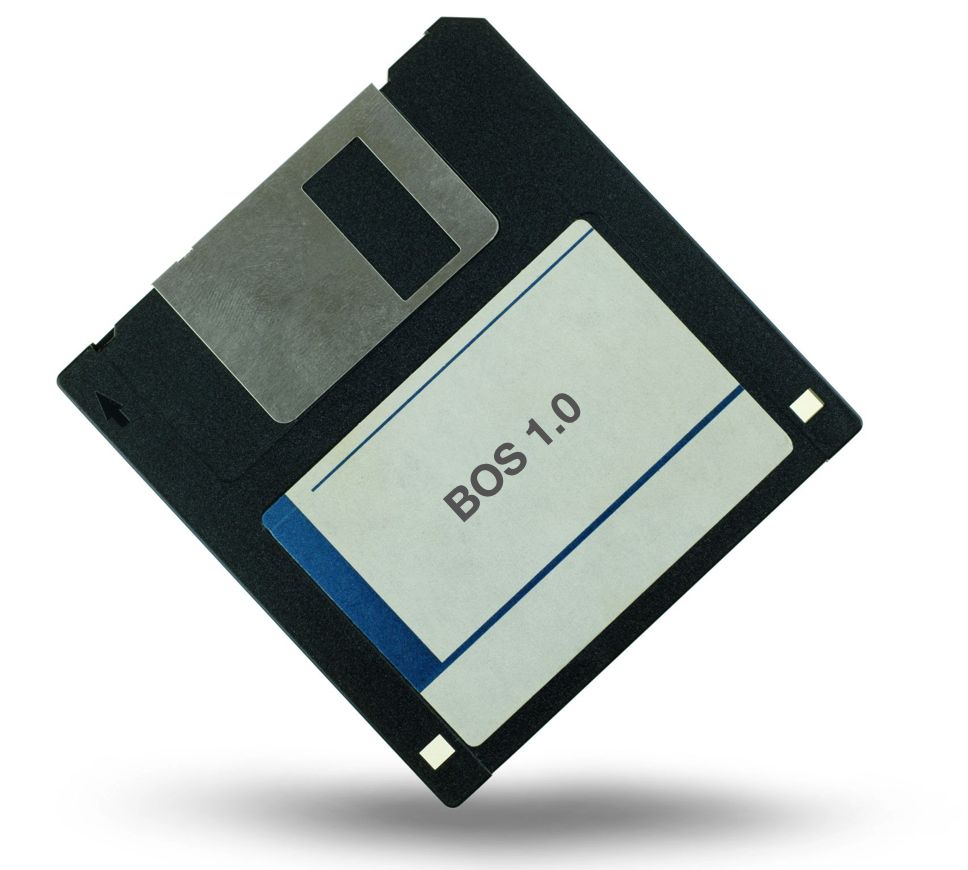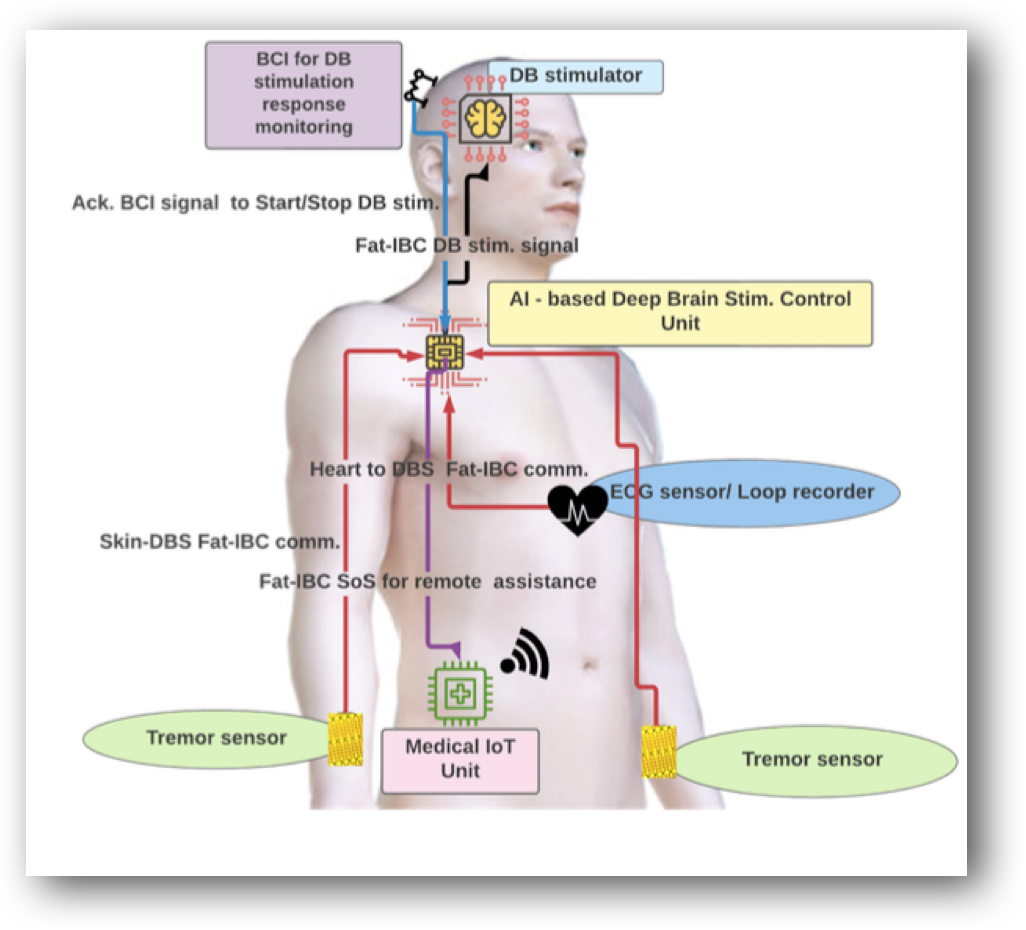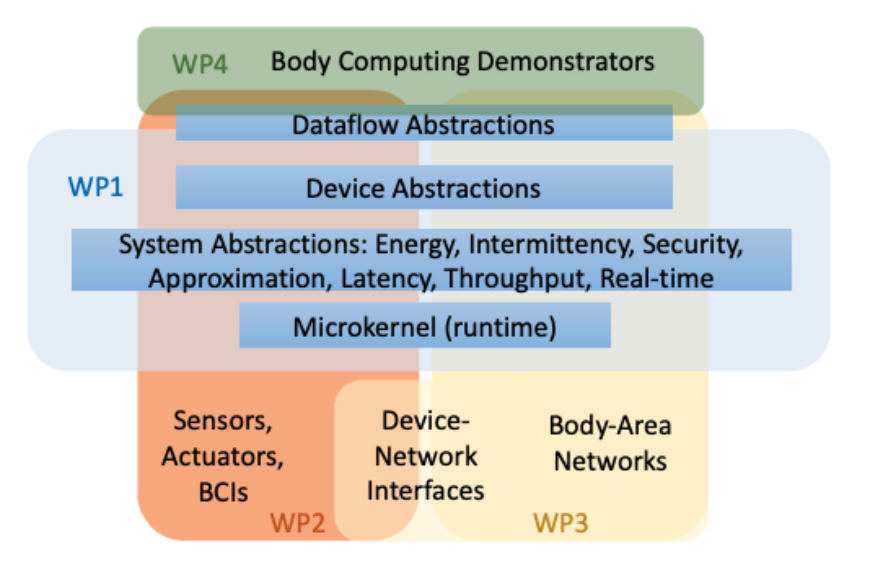
BOS: Software Principles & Techniques for a Body-centric OS
Aiming to facilitate the study of the human body using portable technology, implanted components and brain-machine interfaces, BOS combines computer resources close to the source and in the cloud to enable new smart health services.
Funded by Swedish Foundation for Strategic Research (SSF) 2022 - 2027.
Goal
Consider a future where classical computing subsystems and novel computing subsystems/accelerators meet and integrate into a hybrid, highly complex system. While these systems are expected to perform dynamically and evolve over time to handle new requirements unforeseeable at the design stage, full functionality over ICT infrastructures, e.g., networks, as well as energy-efficiency becomes evident requirements.
BOS seeks to create a cross-platform, modular, and energy-efficient software toolkit for developing body computing applications that employ sensors and actuators in and on, as well as computing platforms outside of human bodies—wearable technology, implanted devices, and brain-machine interfaces, combined with computing resources at the edge and cloud.

With goals beyond the present, BOS aims to support applications that impact the future, for example, deep brain stimulation, a neurosurgical procedure that uses electrical stimulation to treat movement disorders associated with diseases such as Parkinson’s.
Scope

As a multi-disciplinary collaboration, BOS consists of the following work packages:
WP1: Energy-efficient Secure Body Computing
WP2: Sensing and Actuation (including energy-efficient tactile and tremor signals processing software and brain-computer interfaces)
WP3: Energy-efficient Secure In-Body Networking
WP4: Demonstrator with Deep-brain Stimulation
Collaboration
BOS is a collaboration project between the Electrical Engineering and Information Technology departments at Uppsala University (UU), Royal Institute of Technology (KTH), and RISE Research Institutes of Sweden.
Leads of each work packages are:
Work package 1: Professor Stefanos Kaxiras (UU/IT)
(UU/IT)
worked at Bell Labs before coming to Uppsala. His research interests include and memory consistency models, coherence, and microarchitecture with an emphasis on security and (reducing) speculation.
Work package 2: Professor Danica Kragic Jensfelt (KTH)
(KTH)
is Professor of computer science from the Royal Institute of Technology, Stockholm, Sweden. She was named Fellow of the Institute of Electrical and Electronics Engineers in 2016 for contributions to vision-based systems and robotic object manipulation.
Work Package 3: Professor Thiemo Voigt (RISE
(RISE , UU/NES)
, UU/NES)
is Professor for wireless sensor networks at Uppsala University where he leads the Networked Embedded Systems Group as well as the SSF project LifeSec: Don't hack my body. His current research interests include system software for embedded networked devices and the Internet of Things. His work has been cited more than 20,000 times. He is a member of the editorial board for the IEEE Internet of Things and ACM Transactions on Sensor Networks (TOSN).
Work Package 4: Associate Professor Ted Johansson (UU/FTE)
(UU/FTE)
has experience both in large companies in the semiconductor and electronics business, and academic research. He is currently Associate Professor in the Solid-State Electronics group. His research includes CMOS and bipolar process integration and devices, RF circuit and power amplifiers, CMOS analog circuits, FPGAs, and sensors.
Additionally, the following researchers contribute to BOS:
Robin Augustine (UU/FTE), Associate Professor at Uppsala University, working in Department of Electrical Engineering, Division of Solid-State Electronics.
(UU/FTE), Associate Professor at Uppsala University, working in Department of Electrical Engineering, Division of Solid-State Electronics.
Mårten Björkman (KTH), Associate Professor at KTH Royal Institute of Technology working in the Division of Robotics, Perception, and Learning.
(KTH), Associate Professor at KTH Royal Institute of Technology working in the Division of Robotics, Perception, and Learning.
Libo Chen (UU/FTE), Assistant Professor at Uppsala University, working in Department of Electrical Engineering, Division of Solid-State Electronics.
(UU/FTE), Assistant Professor at Uppsala University, working in Department of Electrical Engineering, Division of Solid-State Electronics.
Luca Mottola (RISE
(RISE , UU/NES), Full Professor (Professore Ordinario) at Politecnico di Milano, with adjunct or visiting positions at RI.SE Sweden and Uppsala University.
, UU/NES), Full Professor (Professore Ordinario) at Politecnico di Milano, with adjunct or visiting positions at RI.SE Sweden and Uppsala University.
Mauricio Perez (UU/FTE), researcher at Uppsala University, working in Department of Electrical Engineering, Division of Solid-State Electronics.
(UU/FTE), researcher at Uppsala University, working in Department of Electrical Engineering, Division of Solid-State Electronics.
Pramod Rangaiah (UU/FTE), researcher at Uppsala University, working in Department of Electrical Engineering, Division of Solid-State Electronics.
(UU/FTE), researcher at Uppsala University, working in Department of Electrical Engineering, Division of Solid-State Electronics.
Yuan Yao (UU/IT), Assistant Professor at Uppsala University, working in Department of Information Technology, Division of Computer Systems.
(UU/IT), Assistant Professor at Uppsala University, working in Department of Information Technology, Division of Computer Systems.
Yuchong Zhang (KTH), postdoc fellow at KTH Royal Institute of Technology working in the Division of Robotics, Perception, and Learning.
(KTH), postdoc fellow at KTH Royal Institute of Technology working in the Division of Robotics, Perception, and Learning.
Zhibin Zhang (UU/FTE), researcher at Uppsala University, working in Department of Electrical Engineering, Division of Solid-State Electronics.
(UU/FTE), researcher at Uppsala University, working in Department of Electrical Engineering, Division of Solid-State Electronics.
Popular Science Presentations
Bygger ett kroppscentrerat operativsystem
Framtidens Forskning, 2024-06-12

Idag finns många tekniker som på olika sätt mäter hur kroppen mår eller stimulerar till aktiviteter, det man kallar Body Computing. Med en ökad komplexitet hos sådana system behövs något som liknar ett operativsystem som på ett systematiskt sätt kan koordinera dem.
De forskar på framtidens operativsystem – för kroppen
Voister, 2024-09

BOS är ett forskningsprojekt som fördjupar sig i principer och tekniker för att bygga ett kroppscentrerat operativsystem. Det handlar om mjukvarutekniker som på ett energieffektivt sätt kan behandla data som samlas in via artificiella neurala nätverk, som en kroppsprotes eller en pacemaker. Målbilden? En systematisk plattform som samlar data från en rad sensorer, så att vi ytterst kan förbli friska längre.
Publication
Publications in 2022
- X. Chen, P. Aimoniotis, and S. Kaxiras, “Clueless: A Tool Characterising Values Leaking as Addresses”, in Proceedings of the 11th International Workshop on Hardware and Architectural Support for Security And Privacy, HASP 2022, 2022, pp. 27–34.
Publications in 2023
- J. Feliu, A. Ros, M. E. Acacio, and Stefanos Kaxiras, “Speculative inter-thread store-to-load forwarding in SMT architectures”, Journal of Parallel and Distributed Computing, vol. 173, pp. 94–106, 2023.
- A. Kvalsvik, P. Aimoniotis, S. Kaxiras, and M. Själander, “Doppelganger Loads: A Safe, Complexity-Effective Optimization for Secure Speculation Schemes”, in ISCA ’23: Proceedings of the 50th Annual International Symposium on Computer Architecture, 2023.
- X. Chen, P. Aimoniotis, and S. Kaxiras, “How addresses are made”, in 2023 IEEE International ymposium on Workload Characterization, IISWC, 2023, pp. 223–225.
- P. Aimoniotis, A. B. Kvalsvik, X. Chen, M. Själander, and S. Kaxiras, “ReCon: Efficient Detection, Management, and Use of Non-Speculative Information Leakage”, in 56th IEEE/ACM International Symposium on Microarchitecture, MICRO 2023, 2023.
- N. Rajabi, C. Chernik, A. Reichlin, F. Taleb, M. Vasco, A. Ghadirzadeh, M. Björkman, and D. Kragic, “Mental Face Image Retrieval Based on a Closed-Loop Brain-Computer Interface”, presented at the International Conference on Human-Computer Interaction, Copenhagen, Denmark, July 23–28, 2023.
- N. Rajabi, P. Khanna, S. U. Kanik SU, E. Yadollahi, M. Vasco M, M. Björkman, C. Smith, and D. Kragic, “Detecting the Intention of Object Handover in Human-Robot Collaborations: An EEG Study”, presented at the IEEE International Conference on Robot and Human Interactive Communication, Busan, Korea, Aug. 28, 2023.
- W. Song, S. Kaxiras, L. Mottola, T. Voigt, and Y. Yao, “Silent Stores in the Battery-less Internet of Things: A Good Idea?”, presented at the International Conference on Embedded Wireless Systems and Networks, Sep. 2023.
- C. Singhal, T. Voigt, and L. Mottola, “Application-aware Energy Attack Mitigation in the Battery-less Internet of Things”, presented at the Int’l ACM Symposium on Mobility Management and Wireless Access, Oct. 2023.
- T. Johansson, P. Rangaiah, J. Engstrand, M. Perez, and R. Augustine, “Fat-layer intra-body communication”, presented at Swedish Microwave Days, Stockholm, Sweden, May 23-25, 2023.
- T. Voigt and R. Augustine, “Poster: Towards a Flexbile Network API for Fat In-bodyCommunication”, presented at the International Conference on Embedded Wireless Systems and Networks, University of Calabria, Rende, Italy, 25-27 Sep. 2023.
Publications in 2024
- P. Aimoniotis and S. Kaxiras, “JANUS: A Simple and Efficient Speculative Defense using Reinforcement Learning”, 2024 IEEE 36th International Symposium on Computer Architecture and High Performance Computing (SBAC-PAD), Hilo, HI, USA, 2024.
- Y. Yao, X. Chen, H. Atmer and S. Kaxiras, “TangramFP: Energy-Efficient, Bit-Parallel, Multiply-Accumulate for Deep Neural Networks”, 2024 IEEE 36th International Symposium on Computer Architecture and High Performance Computing (SBAC-PAD), Hilo, HI, USA, 2024, pp. 1-12.
- P. Ekemark, A. Ros, K. Sagonas and S. Kaxiras, “A First Exploration of Fine-Grain Coherence for Integrity Metadata”, 2024 International Symposium on Secure and Private Execution Environment Design (SEED), Orlando, FL, USA, 2024, pp. 62-72.
- A. Asgharzadeh, E. J. Gomez-Hernandez, J. M. Cebrian, S. Kaxiras, and A. Ros, “Hardware Cache Locking for All Memory Updates”, in 2024 IEEE 42nd International Conference on Computer Design (ICCD), Milan, Italy, 2024, pp. 566-574.
- L. Chen, S. Karilanova, S. Chaki, C. Wen, L. Wang, B. Winblad, S. Zhang, A. Özcelikkale, and Z. Zhang, “Spike-Timing Based Coding in Neuromimetic Tactile System Enables Dynamic Object Classification”, Science, 398(66096), pp. 660-665, 2024.
- Y. Zhang, N. Rajabi, F. Taleb, A. Matviienko, Y. Ma, M. Björkman, and D. Kragic, “Mind Meets Robots: A Review of EEG-Based Brain-Robot Interaction Systems”, arXiv preprint arXiv:2403.06186, Mar. 2024.
- H. Xia, Y. Zhang, N. Rajabi, F. Taleb, Q. Yang, D. Kragic, and Z. Li, “Shaping high-performance wearable robots for human motor and sensory reconstruction and enhancement”, Nature Communications, vol. 15, no. 1, 2024.
- Y. Zhang, M. Vasco, M. Björkman, and D. Kragic, “Will You Participate? Exploring the Potential of Robotics Competitions on Human-centric Topics”, the International Conference on Human-Computer Interaction 2024, Cham: Springer Nature Switzerland, 2024. p. 240-255.
- F. Taleb, M. Vasco, N. Rajabi, M. Björkman, and D. Kragic, “Challenging Deep Learning Methods for EEG Signal Denoising under Data Corruption”, in 46th Annual International Conference of the IEEE Engineering in Medicine and Biology Society, EMBC 2024 - Proceedings, 2024.
- Y. Zhang, Y. Ma, and D. Kragic, “Vision beyond boundaries: An initial design space of domain-specific large vision models in human-robot interaction”, in Adjunct Proceedings of the 26th International Conference on Mobile Human-Computer Interaction, pp. 1-8, Sept. 21 2024.
- Y. Ma, Y. Zhang, D. Fu, M. Jahanshahikhabisi, A. Matviienko, M. Bachinski, M. Fjeld, and D. Kragic, “HAID: Human-AI Interaction for Dementia Care”, in Adjunct Proceedings of the 2024 Nordic Conference on Human-Computer Interaction, pp. 1-4, Oct. 13 2024.
- J. Van Haastregt, M. Welle, Y. Zhang, D. Kragic, “Puppeteer your robot: Augmented reality leader-follower teleoperation”, in 2024 IEEE-RAS 23rd International Conference on Humanoid Robots (Humanoids), pp. 1019-1026, Nov. 22 2024.
- B. Wallace, M. van Otterdijk, Y. Zhang, N. Rajabi, D. Marin-Bucio, D. Kragic, and J. Torresen, “Imitation or Innovation? Translating Features of Expressive Motion from Humans to Robots”, in Proceedings of the 12th International Conference on Human-Agent Interaction, pp. 296-304, Nov 24 2024.
- Y. Zhang, K. Kassem, Z. Gong, F. Mo, Y. Ma, E. Kirjavainen, and J. Häkkilä, “Human-centered AI Technologies in Human-robot Interaction for Social Settings”, in Proceedings of the International Conference on Mobile and Ubiquitous Multimedia, pp. 501-505, Dec 1 2024.
- W. Song, S. Kaxiras, T. Voigt, Y. Yao, and L. Mottola, “TaDA: Task Decoupling Architecture for the Battery-less Internet of Things”, The 22nd ACM Conference on Embedded Networked Sensor Systems (SenSys 2024), 2024.
- R. Barjami, A. Miele, and L. Mottola, “Intermittent Inference: Trading a 1% Accuracy Loss for a 1.9x Throughput Speedup”, The 22nd ACM Conference on Embedded Networked Sensor Systems (SenSys 2024), 2024.
- V. Rovelli, A. Maioli, and L. Mottola. “EXTREMIS: Static Frequency Switching for Battery-less Devices”, International Workshop on Energy Harvesting & Energy-Neutral Sensing Systems (ENSSYS - colocated with ACM SenSys), 2024.
- S. Ahmed, B. Islam, K. Yildirim, M. Zimmerling, P. Pawelczak, M. Alizai, B. Lucia, L. Mottola, J. Sorber, and J. Hester, “The Internet of Batteryless Things”, Communications of the ACM, vol. 67, no. 3, pp. 64–73, Feb. 2024.
- T. Johansson, “Neuromorphic Computing and Circuits”, IEEE Nordic Circuits and System Conference (NorCAS), 2024.
- P. Rangaiah, J. Engstrand, T. Johansson, M. D. Perez, and R. Augustine, “92 Mb/s Fat-Intrabody Communication (Fat-IBC) With Low-Cost WLAN Hardware”, IEEE Transactions on Biomedical Engineering, vol. 71, no. 1, pp. 89–96, Jan. 2024.
- J. Engstrand, M. Padmal, B. Mandal, P. Rangaiah, M. D. Perez, M. Mani, R. Augustine, and T. Voigt, “Design Options for Aggregators for In-body Networks”, presented at the International Conference on Body Area Networks, Milano, Italy, 2024.
- K.-F. Krentz and T. Voigt, “More Lightweight, yet Stronger: Revisiting OSCORE's Replay Protection”, NDSS Workshop on Security and Privacy in Standardized IoT (SDIoTSec '24), San Diego, USA, 2024.
- J. Engstrand, K.F. Krentz, N.B. Asan, M. Padmal, W. Yan, L. Joseph, P. Rangaiah, B. Mandal, C. Rohner, M. Mani, R. Augustine, and T. Voigt, “Security and Privacy for Fat Intra-Body Communication: Mechanisms and Protocol Stack”, in Proceedings of the 49th IEEE Conference on Local Computer Networks, 2024.
- K.-F. Krentz and T. Voigt, “Secure opportunistic routing in 2-hop IEEE 802.15.4 networks with SMOR”, Computer Communications, vol. 217, pp. 57–69, Mar. 2024.
Publications in 2025
- E. Gómez-Hernández, J. Cebrian, S. Kaxiras, and A. Ros, “Bounding Speculative Execution of Atomic Regions to a Single Retry”, presented in 30th ACM International Conference on Architectural Support for Programming Languages and Operating Systems (ASPLOS '25), 2025.
- R. Aligholipour, P. Aimoniotis, S. Kaxiras, and Y. Yao, “RXT: Reflexive Address Translation for Pointer-Chasing Workloads”, 2025 IEEE International Parallel and Distributed Processing Symposium (IPDPS), 2025.
- J. Xing, L. Chen, Z. Zhang, M.N. Hasan, and Z. Zhang, “An Intrinsically Knowledge-Transferring Developmental Spiking Neural Network for Tactile Classification”, arXiv:2410.00745, 2025 (manuscript in revision to IEEE Transactions on Neural Networks and Learning Systems)
- P. Rangaiah, B.P.P. Kumar, and R. Augustine, “Improving burn diagnosis in medical image retrieval from grafting burn samples using B-coefficients and the CLAHE algorithm”, Biomedical Signal Processing and Control, vol. 99, 2025.
- P.K.B. Rangaiah, B.P.P. kumar, F. Huss, and R. Augustine, “Precision diagnosis of burn injuries using imaging and predictive modeling for clinical applications”, Sci Rep 15, 7604 (2025).


